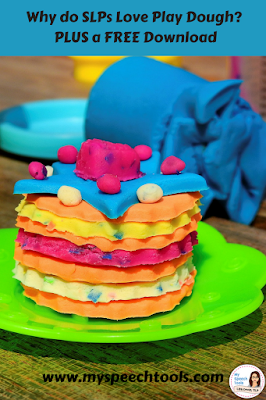Play dough is a staple with any speech-language pathologist. You can find it in our bags, our drawers, our cars, our crates, and cabinets. We stock up at the beginning of the year, replace it at the winter break and even make our own when we want to add fragrance or glitter. But what is it about play dough that makes it a "must have" for SLPs? You will want to read on to discover the secrets behind play dough in speech therapy, and then download the BEST recipe for home made play dough at the end of this post.
Play dough engages the senses in learning opportunities. Using play dough enlightens sight, smell and texture. If you make your own play dough (see recipe below), you can add fragrance for the seasons and glitter for the holidays. One of my favorite play dough add-ins is pumpkin pie spice. My students really enjoy smelling the pumpkin pie seasoning in my play dough during the months of October and November. In the spring, I add lavender oil or rose oil for a floral aroma. Learning experiences become meaningful with sensory activities.
Play dough is an open-ended medium for play. There are so many ways to "use" play dough in your therapy. I have combined play dough with dinosaurs, plastic Easter eggs, toy dishes, plastic bugs, farm animals, Mr. Potato Head pieces, and learning mats (articulation cards, letters, sight words, shapes, ten frames, etc.). In the winter, make white play dough and use Mr. Potato Head pieces to create snow people. Then in October, make orange play dough and use the body pieces to make jack-o-lanterns. In December, make red play dough and use cookie cutters to make holiday cookies with your students. The possibilities are endless. Combine your toys with play dough for something new.
Finally, playing with play dough supports fine motor development, imagination, and social skills. If your students have difficulty holding pencils, writing and cutting, let them spend time squishing and rolling play dough. This will strengthen fine motor skills and facilitate bilateral hand use. While students are improving their motor skills with play dough, watch and listen to the conversations. Play dough then becomes a shared activity for students to problem-solve, work cooperatively, use their imagination, negotiate, and create.
As promised, I've attached the BEST play dough recipe. Click on the image to download. Be creative and enjoy.
Here are a few of my Teachers Pay Teachers play dough products you may want to check out.
Don't forget to sign up for my newsletter below and follow my blog on Bloglovin' or enter your email in the sidebar to receive my blog directly to your inbox. Don't miss a single post.
Lisa, SLP
Subscribe to our mailing list and receive my TIER 2 Vocabulary FREEBIE






No comments:
Post a Comment